“We’re Not Invisible”: Disabled SAG-AFTRA and WGA Members on Accessibility Challenges — and Solutions — at the Picket Lines

On the New York picket lines, where WGA and SAG-AFTRA members have walked since May and July, respectively, actress, writer and director Anita Hollander is used to getting a specific look. The one-legged screen and stage actress is strong — thanks to a regular practice of Pilates — and in good physical health. But she’s also a grandmother dealing with additional stress to her hands as a result of the increased use of her crutches while on the line.
“As I’m walking the line, I know what that face is: ‘Well, if you can do it, I shouldn’t be complaining,'” the SAG-AFTRA member tells The Hollywood Reporter. “The thing is, nobody can really know what it actually feels like.”
More from The Hollywood Reporter
Kate Hudson Still Receives 10-Cent Residual Checks for 'Home Alone 2'
Quinta Brunson Explains 'Abbott Elementary' Time Jump in Season 3
Hollander is one among the 160,000 performer’s union members who have taken to the streets in L.A., New York and other U.S. cities after SAG-AFTRA announced that they were unable to reach a fair agreement with the Alliance of Motion Picture and Television Producers, a trade association representing more than 350 American film and TV production companies. In July, actors, dancers, DJs, puppeteers, recording artists, stunt performers and voiceover artists joined the more than 11,500 film and TV writers already on strike since May.
Amid some of the hottest days on record, writers and performers have picketed at the gates of studio lots and on the sidewalks of studio offices for hours every day, up to five days a week. Once there, they must contend with poorly maintained sidewalks; a lack of shade; ubiquitous scaffolding; the cacophonous, sudden sounds of daily city life; and, at times, dangerous traffic.

“If a sidewalk is too narrow, it’s really hard to turn around in a wheelchair. For folks with disabilities related to hearing or sensitivity to loud noises and big crowds, you can feel overwhelmed being in that space, even if you are walking around,” says Monica Lucas, a pre-WGA writer who previously worked in political activism.
Disabled strikers can also face language that, even unintentionally, excludes them. “The very first picket I went to at Paramount, the chant was ‘Stand up, fight back.’ Even though you’re using it metaphorically, there’s no reason we have to use the words ‘stand up,'” says Christine Bruno, a SAG-AFTRA member. “We’ve got to expand our language. Accessibility isn’t just physical access. There’s a difference between disability inclusion and disability equity.”
Union and pre-union members tell THR that pickets, marches and protests generally lack basic accessibility. And even as the entertainment strikes are fostering a deep sense of solidarity, Bruno says, many know artists who are opting out of the lines over navigation concerns. “In the end, people just stay home and say, ‘I don’t want to have to do that again,'” says Hollander.
“I worry about people thinking that I’m not as active and out there as everyone else, as participatory,” says Jenn Lloyd, a Los Angeles-based WGA writer with Ehlers-Danlos syndrome, a condition that causes chronic joint dislocations. “I’ve gotten the response that you could come to the guild, and help build signs inside, seated in an air-conditioned room. I appreciate having the option, but on the picket line, there’s a camaraderie, community and networking that goes on, and I’m missing out on that if I’m at the guild building signs.”
Bruno, who is based in New York and was given the option to help wrangle the line due to issues maneuvering her scooter over street curbs, agrees. “The strike captains have been great. They’ve tried to help,” she says, adding that captains have information about accessible restrooms and can respond to questions. “But I’m really trying to push that we should be able to ‘walk the line’ if we want to.”

Many disabled writers and performers tell THR that they are willing to endure the challenges of the line as their unions attempt to bring the AMPTP back to the table to secure a better contract. They just want the experience to be safer and easier, to allow more of them to participate.
“What disabled artists want is probably the same thing that everybody wants, which is to be heard and recognized,” says Lucas. “If we can’t be out on the line because of whatever is standing in the way of us getting there, it makes us seem invisible, and we’re not invisible. We want to be a part of the community, and we want the community to be receptive to us being there.”
Outside the HBO and Amazon offices on West 33rd Street in New York, Hollander felt “the sun was beating down the entire time,” after one especially hot day of picketing in Hudson Yards.
As the mercury rose — sometimes above 100 degrees — SAG-AFTRA and WGA have canceled pickets and adjusted their schedules to end lines at midday. But morning temperatures remain grueling for many, particularly those with heat-related conditions or service animals.
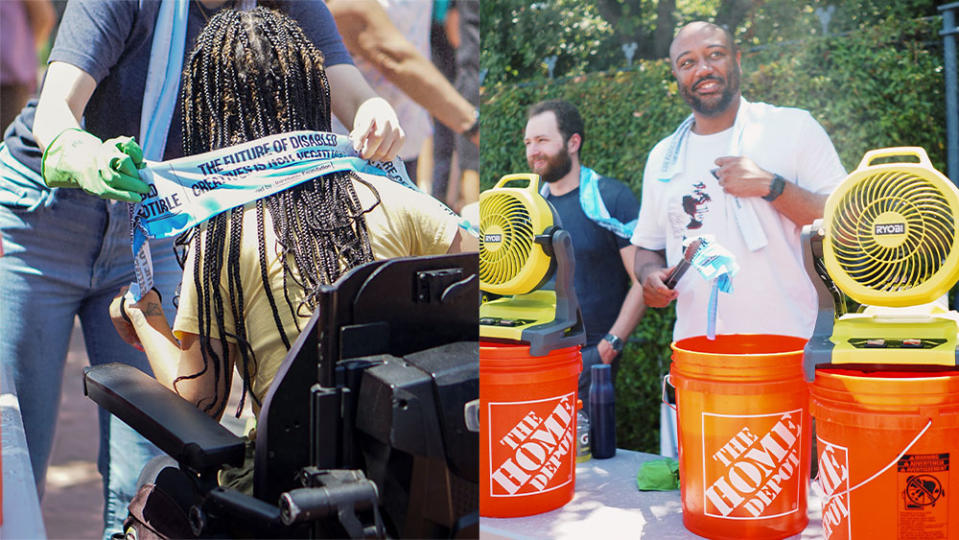
Due to a light sensitivity, Lucas brings a hat and large sunglasses to avoid sensory overload on the Paramount line in L.A. Fellow writer Lloyd, who has an inability to regulate her body temperature and can easily overheat — “especially at lots that have been trimming trees back and reducing shade” — brings a fan, hat and towel to combat temperatures higher than she remembers facing when she picketed with the WGA during the 2007 writers strike.
Lloyd says unions have done a great job “getting donations for water and beverages for us and occasionally an ice cream truck,” which supports those facing food insecurity and with conditions like diabetes. But she and Lucas also credit Inevitable Foundation, which has provided WGA picket lines with cooling stations with fans, chairs and a portable accessible bathroom at their own picket in May, thanks to a donation by California-based nonprofit Momentum.
“There are a lot of conditions people don’t think about that are directly affected by heat,” says Marisa Torelli-Pedevska, co-founder and head of writing programs at Inevitable Foundation. “Having something as simple as a place to cool down and gather themselves and rest is huge. It really is a safety issue.”

Chairs, snacks, water and shade were available at the foundation’s one-day event, which cost an estimated $1,200 and included a survey to assess attendees’ accessibility needs. “It was not a lot of money, and it was deeply appreciated,” says Richie Siegel, co-founder and president of Inevitable Foundation.
Keeping up energy and noise is a key part of the disruptive nature of striking, writers and actors who spoke to THR say, but some of the noise-making, such as honking trucks, is troublesome for picketers. The clamor can be amplified by “sound caverns” in the urban landscape, Hollander says.
“People with bullhorns or speakers — what they’re doing is a good thing. They’re bringing energy to the picket line and keeping people pepped up,” Lucas adds. “But for folks who have sensory impacting disabilities, that can be really overwhelming.”
Lucas and others also suggest that designating certain picket lines as reduced noise spaces could help.
“[My] friend was trying to find a quieter picket line because being on one was just too overwhelming for them,” says Lucas. “A picketing spot to address every disability possible would take a lot of coordination because you have to think about how people with hearing loss are going to have different needs than folks with vision loss. But there could be a picketing spot that’s accessible and supports certain disabilities.”
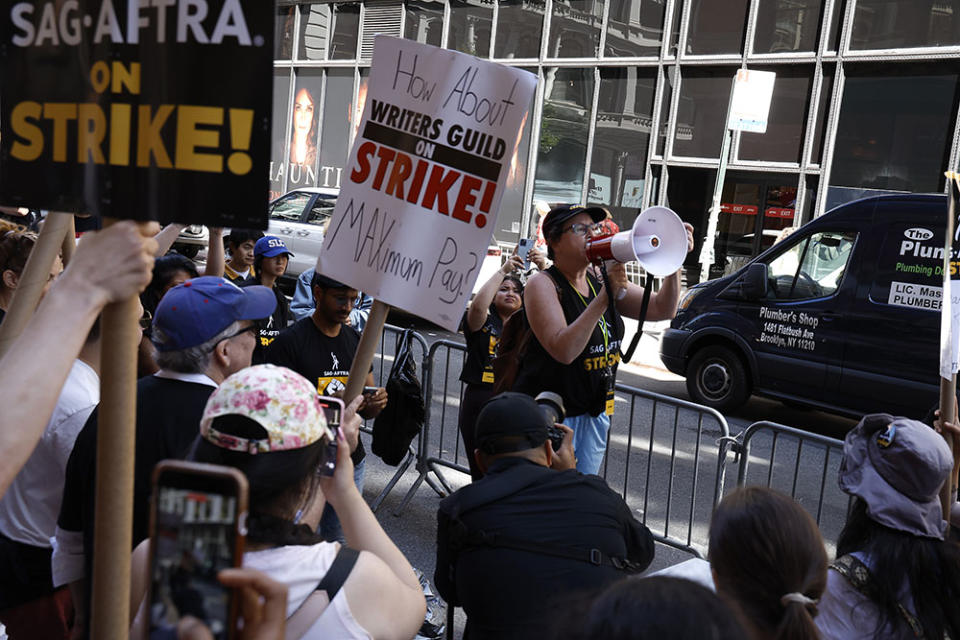
Along with noise and heat, physical strain is an accepted part of the picketing experience. But having a place to rest was key to SAG-AFTRA and WGA members. While they have been encouraged to bring chairs, lugging that extra burden can be arduous for those like Lloyd, who has chronic back pain after three spinal fusion surgeries.
“It’s very hard for me to climb up and down off the ground,” says Lloyd, who was set to lose her union-provided health care on Sept. 1 and has seen her recovery time between pickets lengthen. “I’ve got to bring my cane, hold a sign, I’ve got to wear a giant hat and a cooling fan on my back and my towel. It’s hard on my body to be toting all this stuff around.”
The wide availability of chairs could be appreciated by the wider community, advocates say. “Disabled people may need rest in some ways more than non-disabled people, but when we had chairs [at the Inevitable Foundation picket], everyone was using them,” Torelli-Pedevska says. “Sometimes people need chairs for reasons you wouldn’t even think of — changes in blood pressure or heart rate. This very simple thing can radically change somebody’s experience.”
Needing rest on the line isn’t just a result of physical picketing. The task of getting to the lots and offices can be burdensome in cities where access to public transportation is limited.
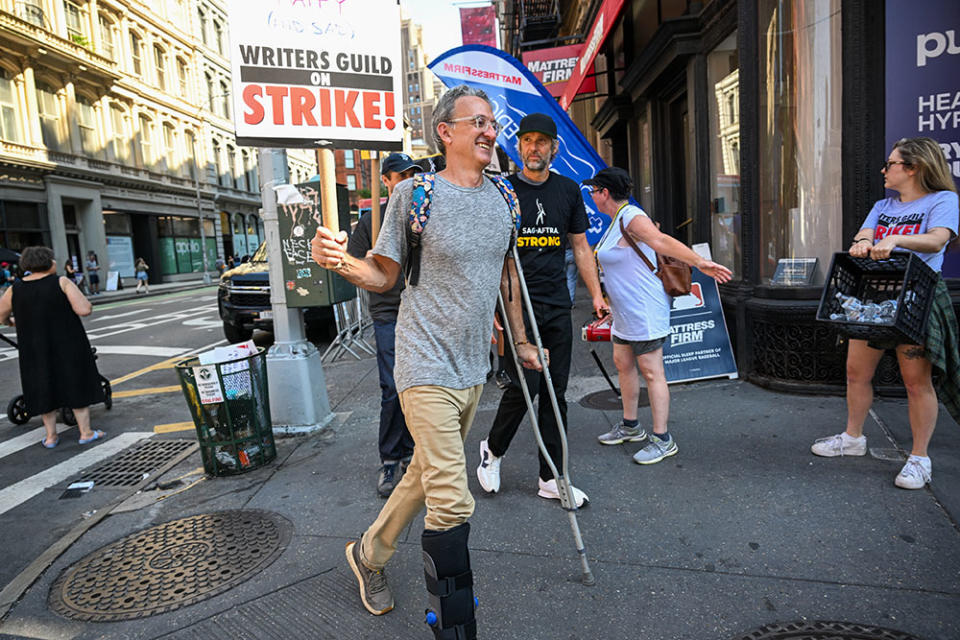
“If you’re walking on crutches from an elevator taking you down to the Metro station and then another down to the subway, there’s a walk between that, and you’ve got to fumble to get your key card out and all these things that on crutches are more challenging,” David Radcliff, a WGA writer who has cerebral palsy and uses crutches and a wheelchair, tells THR.
Driving isn’t always more convenient. “For folks with physical disabilities, it might be hard to get from where they parked to where they need to be,” Lucas says. “I know a couple of folks because of their disabilities aren’t driving, and so they have to pay for Uber to get to where they need to go.”
For those already out of work, driving or ride-sharing to the picket line can also be prohibitively costly. Disabled writers and performers can have fewer savings than their non-disabled counterparts historically employed in greater numbers, for generally higher pay — while shouldering additional costs related to complex health care needs or assistive devices. An Inevitable Foundation report found that 43 percent of surveyed writers had less than three months of savings, and 67 percent had six months or less.
Creatives tell THR that their unions and fellow members have been open to finding ways to address safety issues raised by picketers, like adding barricades and cones on streets with high traffic or assisting them to the picket line by navigating around construction or escorting people to and from inaccurate ride-share drop-offs.
Lloyd says the WGA has made “tremendously helpful” changes since the 2007 strike that give disabled writers the chance to self-address hazards. “The guild has not done what they did in 2007, which was to assign you a lot that you were to go picket at,” she explains. (WGA leadership has not responded to requests for comment.)
But there remain significant elements of the picketing experience out of the unions’ control. Some of the inconveniences and obstacles appear to be the result of “political gamesmanship and strategy,” which “risk people’s lives,” alleges WGA member Marc Muszynski.
Our Office is investigating the tree trimming that occurred outside Universal Studios where workers, writers, and actors are exercising their right to picket.
The trimmed trees are LA City managed street trees.
(Before and after photos below) pic.twitter.com/xczw0bTdh9— LA City Controller Kenneth Mejia (@lacontroller) July 19, 2023
The writer points to such controversial developments as the designation of neutral gates at Radford Studios, and the sidewalk construction and destruction of tree shade at Universal’s lines. “The first place I went was Radford because it’s the closest to my house, and the curb on Colfax was really dangerous. One of my friends actually slipped off trying to keep me from slipping off,” says Muszynski, who is visually impaired.
(Following a THR report about dangerous conditions on its lot, Radford Studios allowed picketing at its main entrance in July.)
Like other striking artists, Muszynski has traveled to a number of lines — paying $35 a day when using a ride-share service — to find the one that feels most comfortable for him. “I tried Universal, the next closest, but the construction that they put there almost got me killed on Lankershim [Boulevard]. Then they pulled out the trees, and I was tripping over the stumps. So finally I’ve landed at Disney, which seems to have the widest, smoothest sidewalks, and I’m more familiar with all the tripping hazards now.”
(NBCUniversal addressed the uproar over the pruning of its trees in July statement: “We understand that the safety tree trimming of the Ficus trees we did on Barham Blvd. has created unintended challenges for demonstrators, that was not our intention. … We support the WGA and SAG’s right to demonstrate, and are working to provide some shade coverage. We continue to openly communicate with the labor leaders on-site to work together during this time.” As for the risks due to construction, the studio restored sidewalk access in front of its lot in early August after the WGA and SAG filed grievances.)
Bruno has settled on Broadway in Times Square after difficult experiences at lines across the city, navigating her scooter up and down curbs and streets, in and out of scaffolding, and around polls and signage in the middle of the sidewalk. It’s “dangerous,” she says, for her mobility device, which “costs $3,000, and it’s not going to be covered if something happens to it.”
“The 30 Rock line was not good for me because of the way it moves due to traffic constraints. You have to go up on the sidewalk and into the street, and there were no ramps,” she explains. “SAG-AFTRA has to clear it with the police and then get a permit. [The union] said they’d just go out and pay for the ramps, put them down and then take them up when we’re done, but they can’t.”
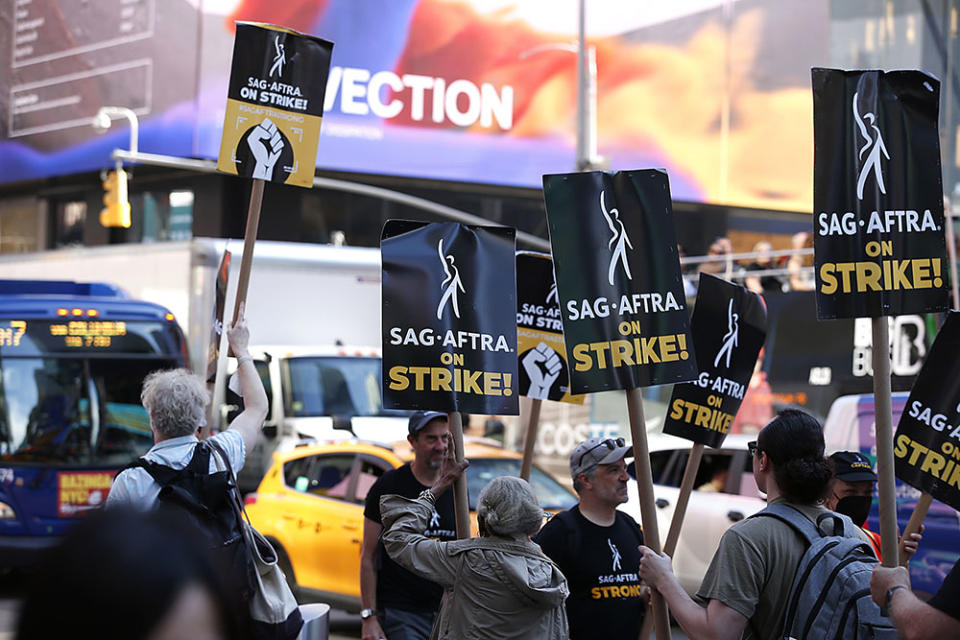
In a statement, a spokersperon for the performer’s union told The Hollywood Reporter that it is “committed to creating an inclusive environment for all members and non-members at our picket lines” and that it not only prioritizes “accessibility at strike locations” but provides “information for our members about each location for those who plan to participate.”
“We value the involvement of everyone who has attended a picket or rally throughout the summer to put pressure on studio executives to bring an end to the strike,” the statement continues. “As we move forward, we recognize that ensuring our pickets, rallies, and events are inclusive and accessible must remain a top priority. We are committed to doing everything we can to prepare for, and improve the experience of our members with disabilities.”
“What’s tricky about this is that the unions are staging this fight on somebody else’s turf,” Muszynski says. “Knowing that we’re going onto other people’s properties, I want to be respectful. I don’t want to cross whatever rules there are, but I also want to be able to express and exercise my right to protest and collectively bargain as an American worker.”
In L.A., disabled writers and performers have been able to address some of these challenges with the help of a spreadsheet created by Katherine Beattie, a WGA strike captain and writer with cerebral palsy who uses a wheelchair. The sheet includes information on the best places for seating, widest sidewalks, quieter lines, shade, parking and more.
“The first week of the strike, [Beattie] reached out to everyone she knew and asked, ‘What picket lines are you going to? What accessibility challenges are you experiencing there?'” says Muszynski. “It was beyond the general info that we get about addresses and where the bathrooms are, so if you had any mobility challenges or vision challenges, you could be aware of that before you go.”
“Later, the guild itself sourced that information and put it on their website,” Radcliff adds. “That wouldn’t have happened without a disabled person taking the initiative to do it.”
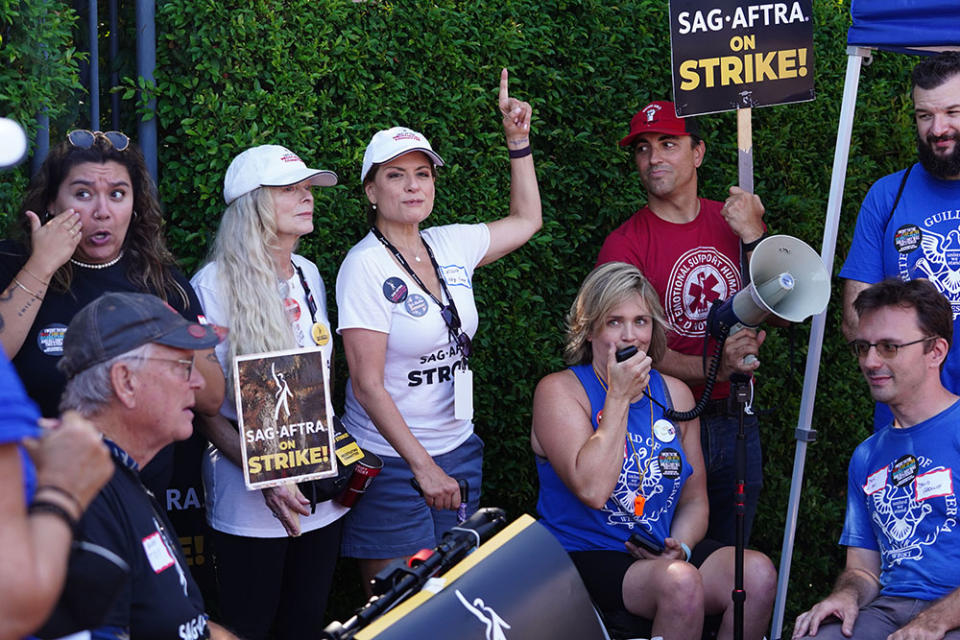
Knowing what is available at a picket location not only opens the door to people who “self-selected out,” Radcliff says, but builds connection between Hollywood’s disability community. That happened at the first themed picket he co-organized in June, which included ASL interpreters — sparking similar efforts by the WGA and SAG-AFTRA.
“During the Sony picket, a guy came up to me and he pointed to his ears to let me know that he was deaf. I thought, ‘Great, because we came prepared for that,'” Radcliff recalls. “I realized that both of the ASL interpreters were at the other side of a lot at that particular time. So for a little while, I was communicating with him by typing a message on my phone and showing it to him, and he walked alongside me in my wheelchair. Obviously, we weren’t able to communicate that much, but when the ASL interpreter got there, it was like somebody turned on the faucet.
He knew about this picket because we advertised it would be accessible to him. He took a bus all the way across town — he doesn’t have a driver’s license,” he continues. “I realized something I’d always kind of intuitively known, but I would have gotten none of that information if not for genuine access.”
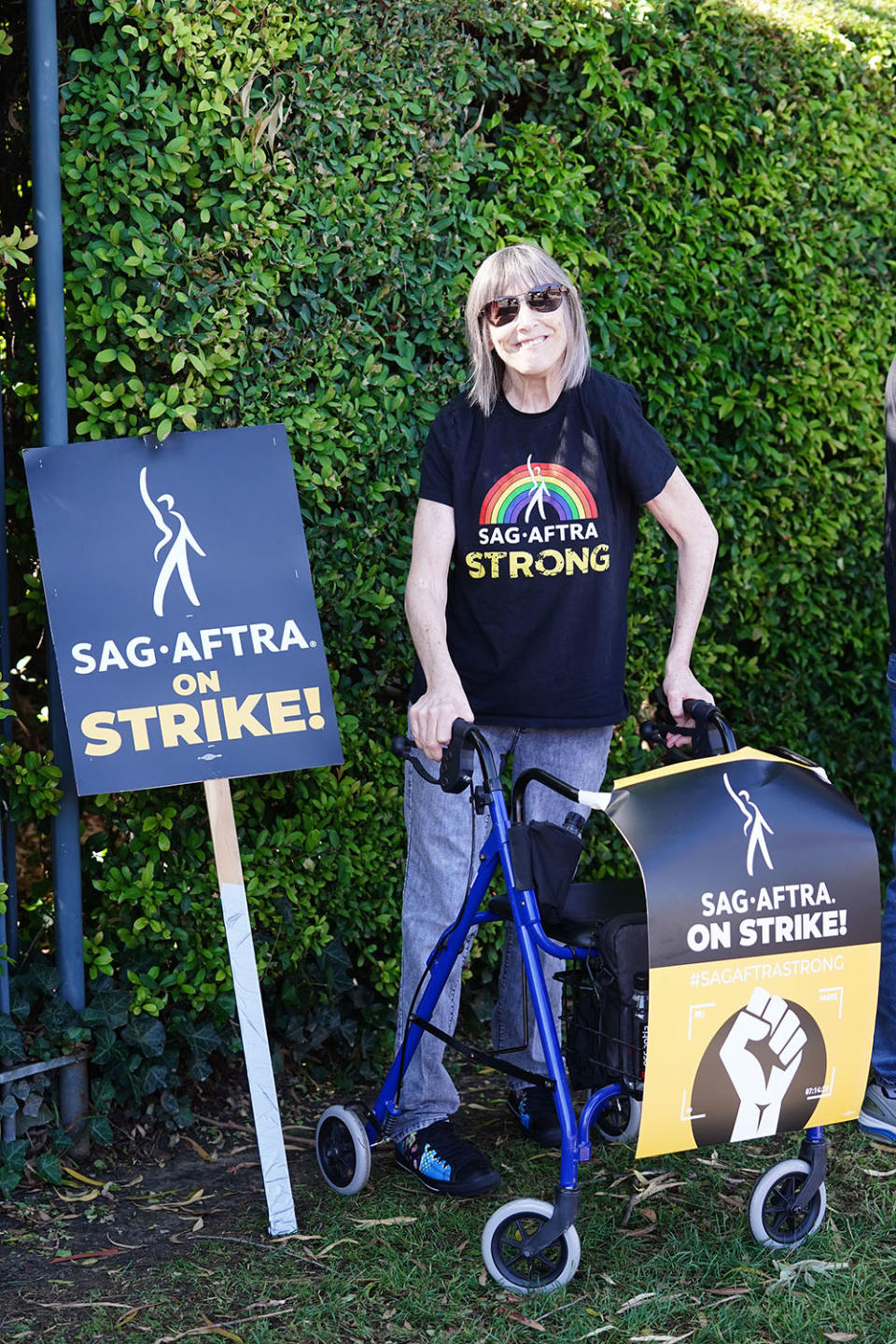
Last Thursday in L.A., Radcliff and Hollander were among the organizers of the first joint picket between the WGAW’s Writers with Disabilities Committee and SAG-AFTRA’s National Performers With Disabilities Committee. (Bruno tells THR there is early discussion around planning a similar event in New York at a later date.)
Picketers tell THR they want such gatherings — like the Inevitable Foundation’s and the Think Tank for Inclusion and Equity’s — to continue, building solidarity and connections among Hollywood’s disabled creatives, and leading to more access ideas such as increased information on social media about picket line accessibility; more sidewalk hazard indicators like cones; and ear plugs to address sensory triggers.
Muszynski also suggests something that can happen anytime on the picket line. “In a world where we can’t control every element of space,” he explains, “one of the best things is just being patient and helpful to other people.”
Sept. 6, 4:25 a.m. Updated with comment from SAG-AFTRA.
Best of The Hollywood Reporter

